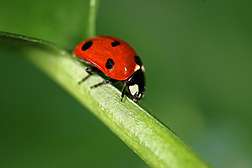Lady beetle diet influences its effectiveness as biocontrol agent

By examining what lady beetles eat, U.S. Department of Agriculture (USDA) scientists are learning more about the movement of these beneficial insects in farm fields—and whether they'll actively feed on crop pests.
Agricultural Research Service (ARS) entomologist Jonathan Lundgren at the agency's North Central Agricultural Research Laboratory in Brookings, S.D., and former ARS entomologist Michael Seagraves were part of a team of ARS and university scientists that examined how a lady beetle's diet alters its feeding patterns and physiology. ARS is USDA's chief intramural scientific research agency.
Lady beetles are deployed as biological controls of insect pests like aphids and Colorado potato beetles. Understanding the feeding behavior of these important beneficial insects will help researchers find ways to most effectively use the lady beetles as biocontrol agents.
In laboratory feeding tests, the researchers found that a lady beetle species called Coleomegilla maculata consumes two to three times more plant tissue after being fed a prey-only diet than after being fed a mixed diet of prey and plant tissue. This suggests that plant material is providing some key nutrients lacking in prey-only diets. It is important to recognize that non-prey foods contain different nutrients than insect prey, and that beetles that are fed mixed diets are often healthier that those fed only on prey, according to Lundgren.
In a followup study, Lundgren and his colleagues found that sugar consumption by lady beetles allows females to survive and produce more eggs than those denied this sweet treat. Foods like sugar and pollen are important components of their diets, and it is thought that lady beetles rely heavily on sugar resources in the field. In this study, Lundgren and Seagraves applied sugar sprays to soybeans and quantified the frequency of sugar feeding by analyzing the gut contents of common lady beetles in South Dakota, Maryland and Kentucky.
According to Seagraves, all the tested lady beetles regularly consumed sugar-like nectar in soybean fields, even when it wasn't applied as a supplement. However, the sugar-sprayed plots had more lady beetles than the untreated plots. This research makes the case that sugar-feeding is very important for lady beetle populations in cropland and suggests a possible way to help maintain beneficial species in agroecosystems.
The research was published in Biocontrol and in Biocontrol Science and Technology.
More information: Read more about this research in the January 2013 issue of Agricultural Research magazine.
Provided by United States Department of Agriculture




















